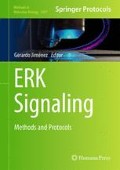Abstract
ERK associates with the actin cytoskeleton, and the actin-associated pool of ERK can be activated (phosphorylated in the activation loop) to induce specific cell responses. Increasing evidence has shown that mechanical conditions of cells significantly affect ERK activation. In particular, tension developed in the actin cytoskeleton has been implicated as a critical mechanism driving ERK signaling. However, a quantitative study of the relationship between actin tension and ERK phosphorylation is missing. In this chapter, we describe our novel methods to quantify tensile force and ERK phosphorylation on individual actin stress fibers. These methods have enabled us to show that ERK is activated on stress fibers in a tensile force-dependent manner.
Access this chapter
Tax calculation will be finalised at checkout
Purchases are for personal use only
References
Ramos JW (2008) The regulation of extracellular signal-regulated kinase (ERK) in mammalian cells. Int J Biochem Cell Biol 40:2707–2719
Helfman DM, Pawlak G (2005) Myosin light chain kinase and acto-myosin contractility modulate activation of the ERK cascade downstream of oncogenic Ras. J Cell Biochem 95:1069–1080
Paszek MJ, Zahir N, Johnson KR et al (2005) Tension homeostasis and the malignant phenotype. Cancer Cell 8:241–254
Sadoshima J, Izumo S (1993) Mechanical stretch rapidly activates multiple signal transduction pathways in cardiac myocytes: potential involvement of an autocrine/paracrine mechanism. EMBO J 12:1681–1692
Sawada Y, Nakamura K, Doi K et al (2001) Rap1 is involved in cell stretching modulation of p38 but not ERK or JNK MAP kinase. J Cell Sci 114:1221–1227
Assoian RK, Klein EA (2008) Growth control by intracellular tension and extracellular stiffness. Trends Cell Biol 18:347–352
Numaguchi K, Eguchi S, Yamakawa T et al (1999) Mechanotransduction of rat aortic vascular smooth muscle cells requires RhoA and intact actin filaments. Circ Res 85:5–11
Vetterkind S, Poythress RH, Lin QQ et al (2013) Hierarchical scaffolding of an ERK1/2 activation pathway. Cell Commun Signal 11:65
Hirata H, Gupta M, Vedula SRK et al (2015) Actomyosin bundles serve as a tension sensor and a platform for ERK activation. EMBO Rep 16:250–257
Conrad PA, Nederlof MA, Herman IM et al (1989) Correlated distribution of actin, myosin, and microtubules at the leading edge of migrating Swiss 3T3 fibroblasts. Cell Motil Cytoskeleton 14:527–543
Walston T, Hardin J (2011) Visualizing cell contacts and cell polarity in Caenorhabditis elegans embryos. In: Sharpe J, Wong R (eds) Imaging in developmental biology: a laboratory manual. Cold Spring Harbor Laboratory Press, Cold Spring Harbor, NY
Gupta M, Kocgozlu L, Sarangi BR et al (2015) Micropillar substrates: a tool for studying cell mechanobiology. Methods Cell Biol 125:289–308
Hirata H, Tatsumi H, Sokabe M (2008) Mechanical forces facilitate actin polymerization at focal adhesions in a zyxin-dependent manner. J Cell Sci 121:2795–2804
Hirata H, Tatsumi H, Lim CT et al (2014) Force-dependent vinculin binding to talin in live cells: a crucial step in anchoring the actin cytoskeleton to focal adhesions. Am J Physiol Cell Physiol 306:C607–C620
Acknowledgements
This work was supported by the Seed Fund from the Mechanobiology Institute at the National University of Singapore.
Author information
Authors and Affiliations
Corresponding author
Editor information
Editors and Affiliations
Rights and permissions
Copyright information
© 2017 Springer Science+Business Media New York
About this protocol
Cite this protocol
Hirata, H., Gupta, M., Vedula, S.R.K., Lim, C.T., Ladoux, B., Sokabe, M. (2017). Quantifying Tensile Force and ERK Phosphorylation on Actin Stress Fibers. In: Jimenez, G. (eds) ERK Signaling. Methods in Molecular Biology, vol 1487. Humana Press, New York, NY. https://doi.org/10.1007/978-1-4939-6424-6_16
Download citation
DOI: https://doi.org/10.1007/978-1-4939-6424-6_16
Published:
Publisher Name: Humana Press, New York, NY
Print ISBN: 978-1-4939-6422-2
Online ISBN: 978-1-4939-6424-6
eBook Packages: Springer Protocols

